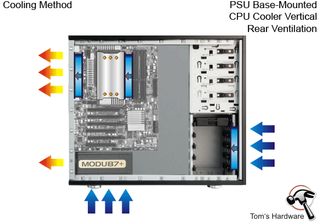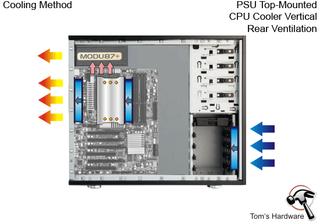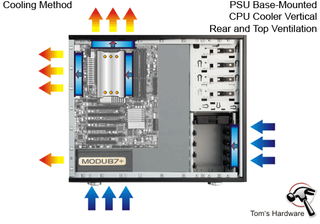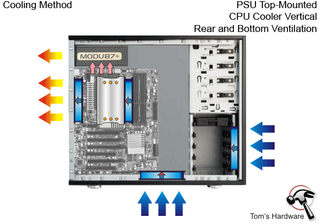How To: Properly Plan And Pick Parts For An Air-Cooled PC, Part 1
What better way to wrap up a scorching summer than with a last word on cooling? We explain the most important rules for creating ideal airflow, address the potential effectiveness of side fans, and discuss the finer points of graphics card cooling.
Airflow: Install Tower Coolers Right-Side-Up
Possible Tower Cooler Installation Options
Tower coolers are preferable to the heat sink and fan combinations that blow air down into the processors (incidentally, both AMD and Intel include these with their retail boxed processors). However, it is of paramount importance that you pay attention to the correct installation orientation.
Because a lot of mistakes can crop up here, we'll take a look at the various installation options before summarizing the most important rules.
Upright Tower Cooler Installation
The vertical assembly is mostly applicable to Intel-based systems. Machines with Socket AM2+- or AM3-based motherboards need a cooler with a special mounting system that allows it to be installed at a 90° angle.

Of course, tower coolers can also be installed in enclosures with power supplies mounted up top. In those cases, the schematic diagram looks like this:

It should be noted that the rear wall must either be perforated or contain a vent. It's even better if there's an exhaust fan in place, which can replace a second heat sink fan in many cases. Of course, it's possible to improve on this scenario as well:
Stay on the Cutting Edge
Join the experts who read Tom's Hardware for the inside track on enthusiast PC tech news — and have for over 25 years. We'll send breaking news and in-depth reviews of CPUs, GPUs, AI, maker hardware and more straight to your inbox.

Even with a top-mounted PSU, airflow can be improved by taking in extra cool air from the floor:

Current page: Airflow: Install Tower Coolers Right-Side-Up
Prev Page Power Supply: Mounting Location And Chassis Selection Next Page Airflow: Horizontally-Mounted Tower Cooler-
compton After reading the charts of PSU placement and the GPU cooling diagrams, I'm even more convinced that my Lian Li PCA05-NB is a great solution. The motherboard is upside down, so that GPUs (In my case an axial fan gpu) faces towards the top. The CPU is now at the bottom back of the case and with the rear fan acting as an intake and not exhaust, you get great CPU cooling. The PSU mounts in the bottome front as well. The great part of this design is all the heat ends up in the top. As an option, you can vent the top to release the heat rising from the GPUs, but I like the case because it has very little venting. Through unusual case design and careful component selection I have an almost silent system - but with overclocked CPU and GPUs. The front fan is the exhaust, but has a bezel over it. With a few bucks worth of acoustic dampening material I can even hear myself think sometimes. I regard low temps and low noise output to be two sides of the same coin, but I know that many seem to not mind loud systems and mainly just care about temps. It's never been easier to build a near-silent system, even with high performance gear.Reply
If you plan ahead of time, you can make a super quiet and cool running system. It's easier to build a cool and quiet system from the start than retroactively go back and try to make a noisy (and/or hot) system quiet with great temps.
I'll be waiting for article 2. -
Mark Heath Good timing as the Australian summer approaches. You guys in the US think you have it hot :SReply -
JOSHSKORN I want my next PC to be able to play Crysis AND make me hot dogs and Iced Frappuccinos.Reply
All kidding aside...curious though, the test setup is on AMD CPUs. What about Intel CPUs? I would assume many of the concepts are similar. -
frostmachine Great guide. I live in a perpetually hot n dusty place. This will come in handy.Reply
Would be better if there's some tips on dust management. -
beetlejuicegr heh i am just showing you a pic from my pc that the airflow is totally different because there is a watercooling system on the cpu, i hope that the picture is self explanatory for all.Reply
-
amirp Hey I have a question... for the PSU you say to not put it in upside down (ie. with it's opening facing up into the chassis..) but this is how I have mine in my ANTEC300 case since there is little room between bottom of case and the PSU if mounted right-side up. So what should I do?!!Reply -
BulkZerker amirpHey I have a question... for the PSU you say to not put it in upside down (ie. with it's opening facing up into the chassis..) but this is how I have mine in my ANTEC300 case since there is little room between bottom of case and the PSU if mounted right-side up. So what should I do?!!Reply
PSU's don't pull that much air, normally. So unless your Unit kicks it's fan speed way up there then don't royy abotu it and do as suggested. If it doesn't work then you can always just flip it back to where it was.
Most Popular

